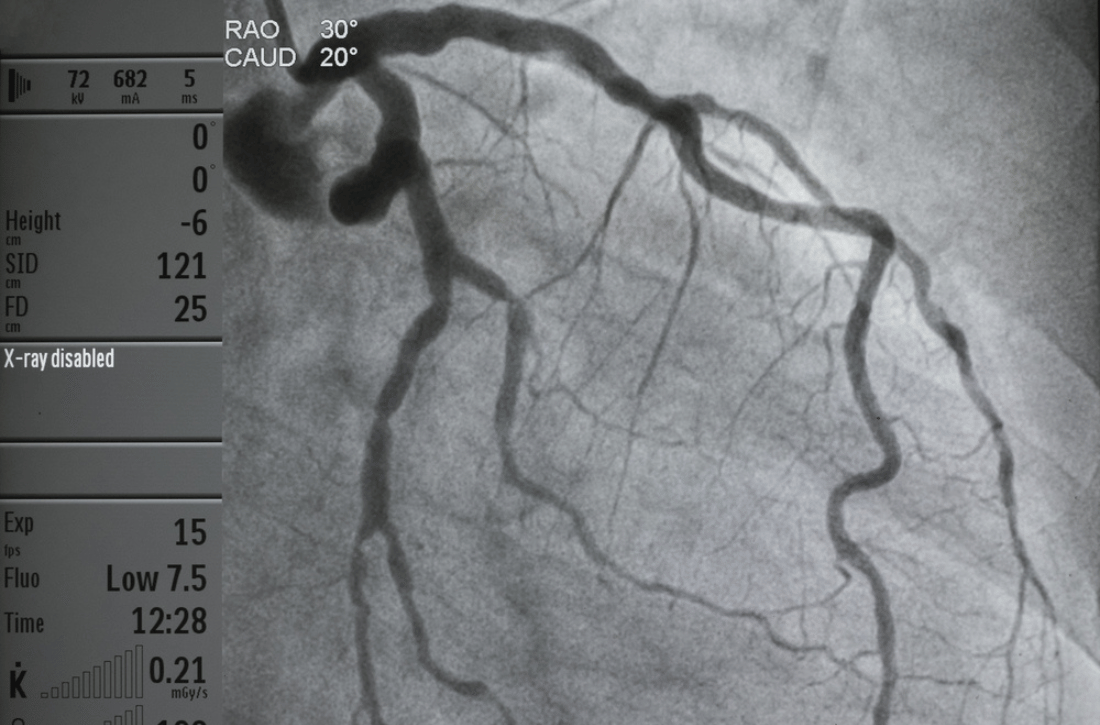Coronary Angiography
Home - Coronary Angiography

Coronary Angiography stands as a cornerstone in modern cardiology, providing crucial insights into the health of the coronary arteries—the vital blood vessels responsible for supplying oxygen-rich blood to the heart muscle. This diagnostic procedure plays an indispensable role in diagnosing and guiding the treatment of coronary artery disease (CAD), enabling cardiologists to make informed decisions for optimal patient care.
What is Coronary Angiography?
Coronary Angiography utilizes advanced imaging technology to visualize the coronary arteries and assess their condition. By injecting a contrast dye through a catheter inserted into a blood vessel (typically in the groin or wrist), cardiologists can obtain detailed X-ray images (angiograms) that reveal any blockages, narrowing, or abnormalities affecting blood flow to the heart.
How Coronary Angiography Works
- Catheter Insertion: A thin, flexible catheter is carefully threaded through a blood vessel to reach the coronary arteries.
- Contrast Injection: Contrast dye is then injected through the catheter, highlighting the coronary arteries on X-ray images.
- Imaging and Analysis: Cardiologists analyze these images to pinpoint the location and severity of arterial blockages or other issues impacting cardiac function.
Benefits of Coronary Angiography
The benefits of Coronary Angiography extend beyond diagnosis, encompassing critical aspects of treatment planning and risk assessment:
- Precision Diagnosis: Provides precise localization and assessment of coronary artery disease, guiding targeted treatment strategies.
- Treatment Guidance: Helps cardiologists determine the most effective interventions, such as angioplasty to open blocked arteries or stenting to maintain vessel patency.
- Risk Stratification: Assesses the risk of future cardiovascular events, allowing for proactive management and lifestyle modifications.
Who Needs Coronary Angiography?
Coronary Angiography is typically recommended for individuals who exhibit symptoms suggestive of coronary artery disease or who are at high risk due to underlying health conditions:
- Symptomatic Patients: Those experiencing chest pain (angina), shortness of breath, or other symptoms of cardiac ischemia.
- High-Risk Individuals: Individuals with risk factors such as hypertension, diabetes, hyperlipidemia, smoking, or a family history of heart disease.
- Post-Event Evaluation: Patients recovering from a heart attack (myocardial infarction) or other cardiac events may require Coronary Angiography to assess coronary artery damage and plan further treatment.
Procedure Details and Preparation
Step-by-Step Procedure
- Preparation: Patients undergo thorough pre-procedure evaluation, including blood tests and electrocardiography (ECG), to ensure readiness for Coronary Angiography.
- Catheter Insertion and Localization: Under local anesthesia, a small incision is made at the insertion site (typically the groin or wrist), and the catheter is carefully threaded through the blood vessel to the heart.
- Contrast Administration: Once the catheter is positioned within the coronary arteries, contrast dye is injected, and successive X-ray images are captured to visualize blood flow and identify any obstructions.
- Diagnostic Evaluation: Cardiologists interpret the angiograms in real-time, assessing the extent and severity of coronary artery disease and formulating a comprehensive diagnostic report.
Duration and Recovery
- Procedure Duration: Typically, Coronary Angiography takes approximately 30 minutes to an hour, depending on the complexity of the case and findings.
- Post-Procedural Monitoring: Patients are closely monitored in a recovery area to monitor vital signs and ensure stability before discharge.
- Recovery and Follow-Up: Most patients can resume normal activities within a day following the procedure, with detailed instructions provided for post-procedural care and follow-up appointments.
Advanced Technology and Expertise
Coronary Angiography is performed using state-of-the-art digital imaging equipment and innovative catheterization techniques. Our team of board-certified cardiologists and interventional cardiologists bring extensive experience and specialized expertise to each procedure, ensuring accurate diagnosis and personalized treatment planning.
Advanced Technology and Expertise
At [Your Clinic/Hospital Name], Coronary Angiography is performed using state-of-the-art digital imaging equipment and innovative catheterization techniques. Our team of board-certified cardiologists and interventional cardiologists bring extensive experience and specialized expertise to each procedure, ensuring accurate diagnosis and personalized treatment planning.
Patient Care and Support
Comprehensive Care Pathway
- Patient Education and Counseling: Prior to Coronary Angiography, patients receive comprehensive education regarding the procedure, its benefits, potential risks, and post-procedural expectations.
- Procedure Day Support: Our dedicated cardiac care team provides compassionate support throughout the procedure, addressing patient concerns and ensuring comfort and safety.
- Post-Procedural Guidance: Following Coronary Angiography, patients receive personalized care instructions, including medication management, lifestyle recommendations, and scheduled follow-up visits to monitor recovery and ongoing cardiovascular health.
Conclusion
Coronary Angiography at [Your Clinic/Hospital Name] represents a pivotal diagnostic tool in the management of coronary artery disease, empowering healthcare providers with critical insights to deliver tailored treatment plans and optimize patient outcomes. With a commitment to excellence in cardiovascular care and patient-centred approach, our clinic/hospital ensures that every individual receives the highest standard of care and support on their journey towards heart health.
FAQ
Frequently Asked Questions
Coronary Angiography is a specialized imaging procedure used to visualize the coronary arteries—the blood vessels that supply oxygen-rich blood to the heart muscle. It helps cardiologists diagnose and assess coronary artery disease (CAD) by identifying blockages, narrowing, or other abnormalities that may affect blood flow to the heart.
Coronary Angiography is recommended for individuals who:
- Experience symptoms of coronary artery disease, such as chest pain (angina) or shortness of breath.
- Have risk factors for heart disease, including hypertension, diabetes, smoking, or a family history of heart conditions.
- Need further evaluation following a heart attack or other cardiac event.
During Coronary Angiography:
- A thin, flexible tube (catheter) is inserted into a blood vessel in the groin or wrist and guided to the heart.
- Contrast dye is injected through the catheter into the coronary arteries, making them visible on X-ray images (angiograms).
- Cardiologists analyze these images to assess the condition of the coronary arteries and plan appropriate treatment.
Coronary Angiography is considered a safe procedure when performed by experienced healthcare professionals in a controlled clinical setting. While rare, potential risks include bleeding at the catheter insertion site, allergic reactions to the contrast dye, or damage to blood vessels.
Preparation typically includes:
- Fasting for several hours before the procedure.
- Informing your healthcare provider about any medications you are taking, as some may need to be adjusted.
- Arranging for transportation home after the procedure, as you may be advised to rest for a short period following Coronary Angiography.
- During the Procedure: You will receive local anesthesia at the catheter insertion site to minimize discomfort. The procedure itself may take up to an hour, during which you will be monitored closely.
- After the Procedure: You will be monitored for a short period to ensure stability before discharge. Most patients can resume normal activities within a day, although you may be advised to avoid strenuous activities for a short period.
Based on the results of Coronary Angiography, your cardiologist will discuss:
- The presence and severity of coronary artery disease.
- Treatment options, which may include medication, lifestyle changes, angioplasty, or coronary artery bypass grafting (CABG).
- Long-term management strategies to reduce the risk of future heart problems.
Your cardiologist will review the angiograms immediately after the procedure and discuss preliminary findings with you. A comprehensive report, including detailed findings and treatment recommendations, will be provided to you and your referring physician promptly after the procedure.
Depending on your medical history and specific circumstances, alternatives may include non-invasive imaging tests such as CT angiography or stress testing. Your cardiologist will recommend the most appropriate diagnostic approach based on your symptoms, risk factors, and overall health.
To schedule a Coronary Angiography or learn more about the procedure, including insurance coverage and preparation guidelines, please contact [Your Clinic/Hospital Name]. Our scheduling team will assist you in arranging a convenient appointment and addressing any questions or concerns you may have.
